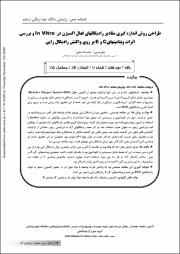| dc.contributor.author | Shams, safar | en_US |
| dc.contributor.author | Safari, mohammad reza | en_US |
| dc.date.accessioned | 1399-08-21T21:46:19Z | fa_IR |
| dc.date.accessioned | 2020-11-11T21:46:19Z | |
| dc.date.available | 1399-08-21T21:46:19Z | fa_IR |
| dc.date.available | 2020-11-11T21:46:19Z | |
| dc.date.issued | 2005-08-01 | en_US |
| dc.date.issued | 1384-05-10 | fa_IR |
| dc.identifier.citation | Shams, safar, Safari, mohammad reza. (2005). Development of a Method for measuring Reactive Oxygen Radicals Levels In Vitro and Study the Effects of Vitamin C and E on Radical Production Reaction. scientific magazine yafte, 7(2), 23-29. | en_US |
| dc.identifier.issn | 1563-0773 | |
| dc.identifier.uri | http://yafte.lums.ac.ir/article-1-1076-en.html | |
| dc.identifier.uri | https://iranjournals.nlai.ir/handle/123456789/483461 | |
| dc.description.abstract | Background: Free radicals and reactive oxygen species(ROS) are the most important factors in formation of oxidative stress reaction. Now, radical damage has been suggested to contribute to a wide variety of diseases such as Alzheimer, atherosclerosis and cancer. Transition metal ions in the presence of the various biomolecules produce these active compounds. The aim of this study is introducing a new and rapid method for measuring of ROS.
Materials and methods: In this cross-sectional study, the amount of free radical production by transition metal ions such as iron, copper and vanadium in the presence of the thiol group-containing glutathione and cysteine(as reducing agents) and molecular oxygen was measured in vitro by thiobarbitturic acid(TBA) test. For measuring free radicals levels, the suger deoxyribose was used as a detector molecule. Attack of free radicals on deoxyribose produces a number of aldehyde compounds such as malondialdehyde(MDA). Then, MDA was combined with TBA as a detector, which makes a chromogen with maximum absorption at wavelength 532nm. Also, the effects of vitamin C and E on the radical production by these metal ions were studied.
Findings: Vanadium was considerably more effective than iron and copper (Pvalue<0.05) to generate free radicals. The generation of free radicals by iron and copper was depended on the presence of glutathione or cysteine in medium(for Fe-glutathione system was 0.611±0.039 and for Cu-cysteine system was 0.592±0.033). Vitamins C and E had an inhibitory effect on the radical production by three metal ions that were used (Pvalue < 0.05). Specially, vitamin C in 100 micromolar concentration had the greatest effect on free radical formation(83% Inhibition with
P value < 0.05).
Conclusions: These results suggest that reaction of transition metals with thiols in the presence of oxygen, generate ROS, and vitamin C and E inhibit free radical production. | en_US |
| dc.format.extent | 260 | |
| dc.format.mimetype | application/pdf | |
| dc.language | English | |
| dc.language.iso | en_US | |
| dc.relation.ispartof | scientific magazine yafte | en_US |
| dc.relation.ispartof | مجله علمی پژوهشی یافته | fa_IR |
| dc.subject | Free Radical | en_US |
| dc.subject | Oxygen | en_US |
| dc.subject | Transition Metal | en_US |
| dc.subject | Thiols | en_US |
| dc.subject | Vitamin C | en_US |
| dc.subject | Vitamin E | en_US |
| dc.title | Development of a Method for measuring Reactive Oxygen Radicals Levels In Vitro and Study the Effects of Vitamin C and E on Radical Production Reaction | en_US |
| dc.type | Text | en_US |
| dc.type | Research | en_US |
| dc.citation.volume | 7 | |
| dc.citation.issue | 2 | |
| dc.citation.spage | 23 | |
| dc.citation.epage | 29 | |





